by Bill Murray
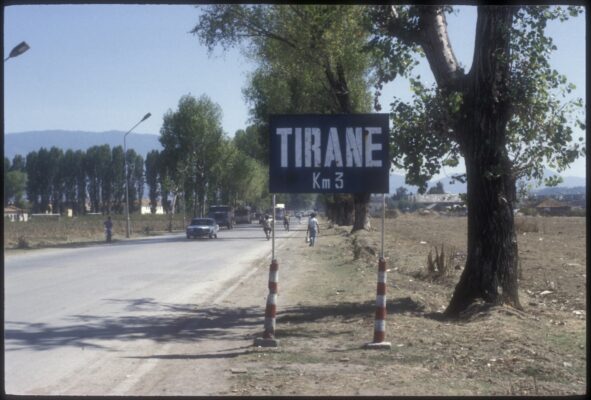 The Balkans isn’t everybody’s first choice for summer holiday, but that’s where we’re headed this year. First we’re flying to Chișinău, while we still can, and I don’t mean to be flip. Forgive my wavering confidence in Western guarantors of freedom, democracy and territorial integrity.
The Balkans isn’t everybody’s first choice for summer holiday, but that’s where we’re headed this year. First we’re flying to Chișinău, while we still can, and I don’t mean to be flip. Forgive my wavering confidence in Western guarantors of freedom, democracy and territorial integrity.
My idea then is to press south from the Moldovan capital through Romania and Bulgaria. Later we’ll head to Skopje, Lake Ohrid, Pristina and Tiranë. No Disneyland for us this summer. We’re going to Plovdiv.
Where my wife comes from in Nordic Europe, thuggery isn’t street crime and graft. Up there, thuggery plays out against dramatic backdrops, with a sense of the cinematic. It’s oligarch families flying drones through the Arctic, or it’s cynical manipulation of human lives, Russians importing Somali “asylum seekers,” then renting them bicycles to pedal off toward the Finnish border.
In the Balkans it’s not like that. Down there, we’re led to believe unkempt rogues and opaque political intrigue are common as London fog. In the Balkans, they say, thuggery is bona fide. Local. Home grown. And scoffing at the law starts with the leader.
Witness for one, Albania’s former strongman, Enver Hoxha. Using summary executions, arbitrary imprisonment and torture to consolidate power, after World War II, Hoxha made the world’s best ever run at isolationist, North Korea-style total autarky.
A measure of Hoxha’s success is how, not that many years ago, for most people Albania was completely off the map. Not only did Hoxha close Albania to foreigners, other countries played along, too, discouraging travel there by their citizens right through the 1980s.
The United States and Albania had no diplomatic relations from 1946 to 1991. The State Department issued anti-Albanian travel advisories, warned would be visitors about the country’s dire infrastructure, about the likelihood they would be harassed if they visited, and generally wagged its institutional finger at the very idea of your turning up in Tiranë.
It took a 1995 visit by then Secretary of State Madeleine Albright to finally break that barrier, and as with every visitor to Russia in the 1980s, what few travelers did pass through, thought, what? We were afraid of this!?!
For the longest time Albania didn’t even realize its despotism game was up. A heart disorder killed Hoxha in 1985, but his hand-picked successor carried right on in Albania’s version of splendid isolation until 1992. By then, authoritarian governments in Bulgaria, Czechoslovakia, East Germany, Hungary, Poland and Romania had collapsed, and Yugoslavia convulsed on Albania’s borders.
As late as November 13, 1989, after the breach of the Berlin Wall, a New York Times reporter named Marvine Howe was “believed to be the first American journalist to visit Albania since the 1960’s,” having been admitted on a closely supervised tour the paper headlined ISLAND IN THE BALKANS.
“Ox carts, donkeys and rattling Czech trucks are the main means of transportation in the countryside. In the cities, people mostly walk or take decrepit buses. Bicycles are rare. Statues of Stalin and his Albanian disciple, Enver Hoxha, abound. In every town and village, billboards and signs glorify Mr. Hoxha, who ruled Albania for four decades.…”
Hoxha had a lifelong problem with keeping friends. After breaking off alliances with Marshall Tito, Nikita Khrushchev and Chairman Mao in turn, Hoxha faced a dwindling roster of potential allies. As Robert D. Kaplan put it, the ruptures of Albania’s three big alliances marked “the only distinctive time pegs in an otherwise monotonous and monochrome existence for average Albanians.”
(When he broke off relations with the Soviets in 1960, Hoxha feared Khrushchev would have him killed and refused to fly home. His train trip from Moscow to Tiranë took more than a week.)
We think paranoia; Hoxha thought more in terms of “self-reliance.” He led Albania for 43 years, all the while, like the self-appointed King Zog before him, doggedly ring-fencing a hapless, ill-educated peasantry.
On our arrival in Tiranë in 1993, we piled into an older Mercedes with a hole where the radio once had been, and bumped the twenty-plus kilometers into town, traveling alongside a unique mix of horse and donkey carts and dark, new BMW’s (would-be future oligarchs were newly emergent even then). Corn grew alongside grapevines and Roma boys chased chickens with sticks beside the road.
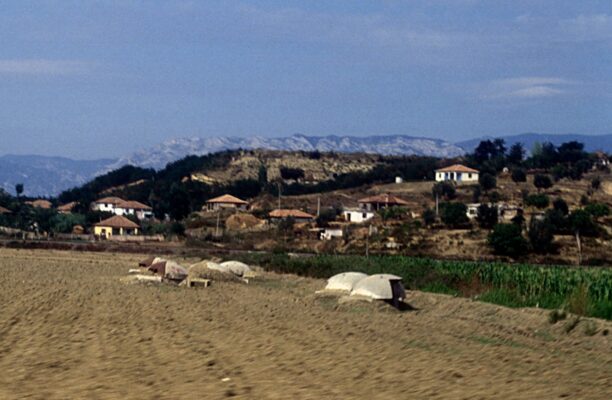
Hoxha’s most notable stab at architectural relevance was a series of ubiquitous, round concrete bunkers, laid out in haphazard fashion all across the landscape. They were waist-high, commonly six or eight feet in diameter and meant to hold a handful of comrades each. From these bunkerët, (bunkers), or dhomat e rezistencës (houses of resistance), fighters were to fire machine guns and mortars and hurl grenades to repel invaders.
(Alas, everything old is new again: news came last weekend that Estonia will build new bunkers along its 294-kilometer border with Russia. Each bunker is designed to accommodate 10 soldiers, and Estonia will start with 600. Enver Hoxha played in a different league. Estimates are, Hoxha built 750,000.)
Local folks apologized for the bunkers before it sunk in what they were. They had slits near the ground to stick rifle barrels through. As it turned out no invaders ever turned up.
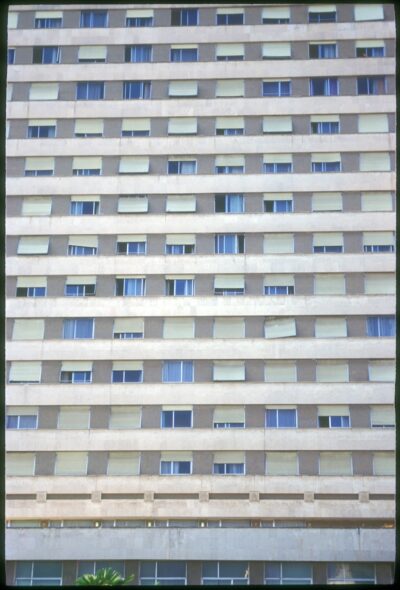
Sitting on the lawn outside the hotel, we drank local brandy distilled from grapes from our new friends’ home stash. Clear, home brewed and poured into a Cuervo bottle, it kept us out much of the night. Somebody’s uncle made it.
Our friends described school under Hoxha.
“Everything had to be ‘revolutionary,’ so when we were at school we had to go through what they called the revolutionary triangle. That was learning, literary training and physical labor.”
We asked about the physical labor part.
“Anything. We could go help build a building, we could do farming. Once they were building the martyrs’ cemetery. We had to carry some marble blocks and it was January and February. It was cold on top of the hill. It was terrible.” A rueful chuckle. “Also we have taken part in so many railway construction sites.”
Away from the main square and down a broad boulevard, shortly came a point beyond which Albanians could not go. In the 1960s, Hoxha and other Albanian leading lights began confining themselves here, in a self-sufficient district known as Blloku, the Block.
The former leadership lived there in self-imposed siege, alongside a knockoff of the old Soviet beriozka shops selling the best groceries and western clothes. Blloku contained a “leisure house” that screened banned films, and pharmacies with western medicine. Post-Hoxha, by 1993 Blloku was open and peaceful with new kiosks popping up like mushrooms, and on that afternoon years ago, a whole pig roasted on a spit.
Hoxha was a big man – he was almost 6’5 – who held big grudges. Every Hoxha biography speaks of his murderous meanness. Most tell the story of his having girls shot who had rebuffed him in elementary school. Even so, for a murderous dictator, Hoxha’s villa was so modest as to be almost endearing, Florida-style with verandas and loads of plate glass.
Over to the south of Lake Ohrid, near the border with North Macedonia, is a place called Vila ART, now a bar, restaurant and hotel but once Enver Hoxha’s country residence. It gives every indication of being modest, too, in the pictures. Today it offers “Comfort, freshness and tranquility” on the nearby town’s web site. (It doesn’t seem to have its own.) I aim to try to rent the dictator’s former sleeping quarters for a night later this summer.
•••••
Sailing away from Albania’s port of Durres to Trieste aboard the M/v Espresso Grecia, we met Skender “Neri” Metaj, a 36 year old artist-painter with a half-gray head of hair. He told us about life.
Back in Tiranë, there was one TV channel, usually broadcasting from 1000 – 2300. Out on Mt. Dajti antennae received Italian TV, but it wasn’t pumped into Tiranë homes. Neri, roughly self-taught in English, told us that in Durrës he could pull in Italian TV from across the Adriatic, over the air.
In the old days he had to watch with the sound down low, secretly, so neighbors wouldn’t report him to the Sigurimi, the secret police. If you were found watching Italian TV, he said, you’d get a “bad biography,” which would keep you – and all your family – out of decent jobs, often for life.
His teacher spent fifteen years in jail for painting in the style of Chagall and Van Gogh. Neri told us, “Communism has stolen my life.”
As non-Albanians boarding the ship in Durres we stood out, and the Adriatica line afforded us special treatment we didn’t ask for, but neither did we refuse it. The Italians running the ship seized everybody’s passports for the duration of the journey but at the end they returned our passports so we could disembark before the Albanians, who then endured a mighty scrum.
So, so chauvinist. It’s not that we weren’t glad to leave the ship; it was hardly plush. Yet the whole trip had been like that; we were uncomfortably entitled. The whole post-Soviet and very fleeting unipolar moment played out that way. We’d been lira millionaires in Istanbul a week before (Turkey was having one of its bouts of inflation), the former Soviet Union reeled in dire post-collapse desperation and meanwhile we could, and did, scamper around the world, anytime, wherever we wanted.
With one glaring exception: we grimaced and diverted our eyes as the M/v Espresso Grecia sailed north past the wars of Yugoslav independence that were then grinding on just beyond our view of the Bosnian and Croatian shores.
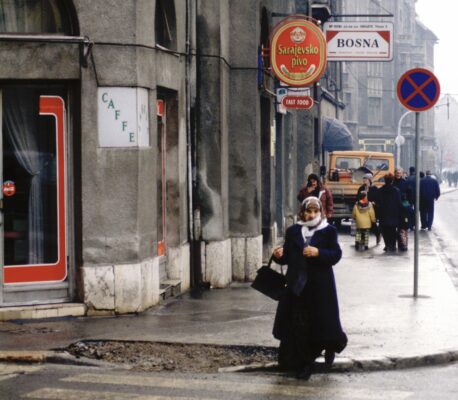
We waited four more years before we flew to Sarajevo. I don’t mean to make anything about that trip sound the least bit intrepid. The wars were over, moving about was safe and the days of fighting were firmly past. The entire population was exhausted. By November 1997, the biggest business in downtown Sarajevo seemed like busting down curbs for people with ambulatory problems and in wheel chairs. They were up to a lot of that.
The Dayton Accords forced the warring sides apart and brought the shooting to a stop in early 1996, and before you knew it the press was running those “life is beginning to return to normal,” sorts of stories to make Western Europeans and the United States forget they had peered between their fingers for too long to prevent atrocities at Srebrenica, around Prijedor, in the shattered ‘Bihac pocket’ and many other places besides.
If life was beginning to return to normal, then back home in the United States we could look away and forget all about this nasty little war. Hell, they were busy forgetting about it fifty air minutes north of Sarajevo in Vienna. But those stories about life returning to normal in Sarajevo, they were bullshit.
A year and nine months after the Dayton Accords, it was true, I was sitting in the partially repaired (gaily bright yellow) Sarajevo Holiday Inn drinking a Tuborg. There were even billboards with colorful advertising down along the airport verge. But just behind them stood rows of destroyed flats, family rooms naked to the sky.
The only way into or out of town for those trapped during the siege, Muslims mostly, had been to run across the airport runway. Which opened those who tried to flee to snipers. Radio reported the casualties every day. Eventually they built a 1.2 meter wide, 1.6 meter high tunnel, but not for ordinary folks; they built it to move Bosnian army munitions, politicians, diplomats, eggs and potatoes.
Destroyed flats, still open to the sky, continued all the way into town. For 1425 days, longer than the siege of Leningrad, Sarajevo had been pulled open at the chest and held down, held open.
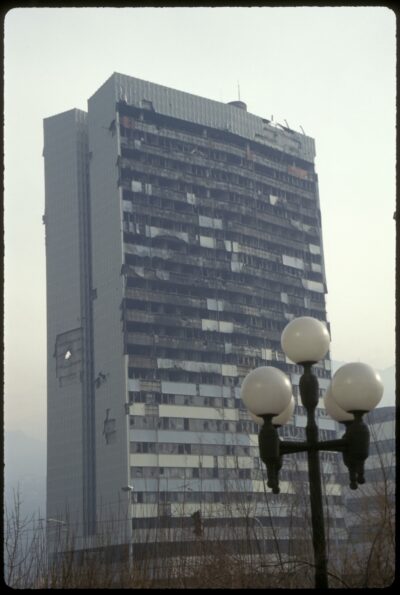
The attack on the city began on April 6, 1992, when Radovan Karadic’s Serbian snipers opened fire (probably from inside the Holiday Inn) on a huge crowd demonstrating against the division of the country across ethnic lines. That demonstration was held at the parliament building, which was hit by hundreds of shells over the course of the war. The Holiday Inn stood alone, not quite all the way to the center of town, opposite the parliament building on a wide avenue called Zmaja od Bosne, but known as Sniper Alley.
At the time of our visit, the Holiday Inn only took cash in advance in German marks, and the price list read like this: overnight with breakfast 390 deutsche marks cash in advance. Only. “Overnight price includes: self–service breakfast, customer insurance, state registration.”
The lift opened onto shot up carpet in the little lobby on our assigned floor. We drew back the drapes onto a fine view of the parliament building, proximity to which was the reason the Holiday Inn was initially popular with the press. Between here and the shattered Parliament stood an SFOR armored personnel carrier directly across the street, gun turret manned, armed soldiers smoking in a circle around it. SFOR stood the United Nations Security Force.
As the war went on the Holiday Inn gained a reputation as a war hotel like the Meikles in Harare, the Continental, Caravelle and Rex in Saigon and Belfast’s Europa (“the most bombed hotel in Europe”). It made its name as a war correspondents’ refuge and eventually even earned its own book. After a four-year siege, I’m surprised the damage wasn’t more dire.
The destruction on the road from the airport was worse.
Dark was coming fast (the sun goes behind the hill well before dark in November), we didn’t know where we were and we weren’t yet sure about all of this. The streets coming from town were busy: cars, pedestrian traffic, full trolleys. If they could do it we guessed it was okay, and so it was.
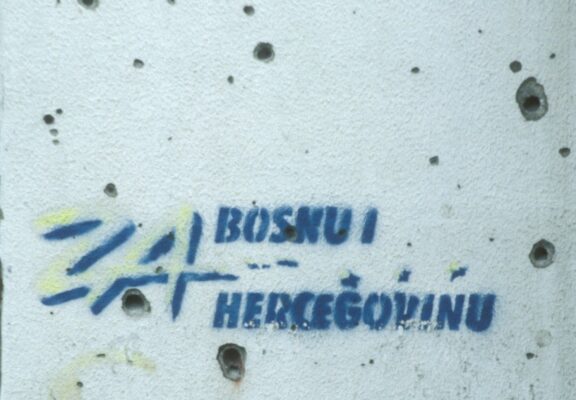
Don’t get me wrong, it was pretty rough. Virtually everywhere with a face toward a Serb-held hill was full of bullet holes; the street level bullets had been meant for people. In the park in the center they had buried people during the siege – some more than one to a grave, some less than six feet down, some without a casket. Near the graves sat scarved, lost Muslim women and their babies with utterly nowhere in this world to go.
Into town destruction appeared random, but farther along Ulitsa Maršala Tita, one street in from the riverfront, there wasn’t much damage, at least showing. There was no way to shoot there from the hills (except just to lob shells – which is apparently what happened at the Markale flower market, killing 68.
Consequently Tito Street was alive with traffic and shops and confectionery bars. It led us up into pedestrian forks that branched off smaller and smaller into cobbled streets and became Baščaršija, the old Ottoman trading quarter, a coffeehouse in every other storefront serving dark strong thick Turkish coffee, where old men sat unmoving for hours. I suspect they’d done just so, for centuries.
•••••
It’s notable how many public officials, journalists, thrill-seekers and others passed through wartime Sarajevo earlier in their careers and then went on to later roles in government and media.
Javier Solana of Spain went on to become a NATO Secretary General. Both he and the UK politician Paddy Ashdown served as High Representatives for Bosnia and Herzegovina. The journalists Misha Glenny, Chris Hedges, Scott Pelley and Sam Kiley reported from Sarajevo.
Roger Cohen was appointed The New York Times’ Balkan bureau chief in April 1994, just as the war reached its peak. After graduating with a BA from Yale in 1992 Samantha Power filed freelance human rights-based reporting from Sarajevo, then went on to serve as US Ambassador to the UN and now, USAID Administrator.
Susan Sontag brought a dose of humanity to an inhuman monstrosity of a war by recruiting an acting troupe from starving Sarajevan artists and staging a defiant Waiting for Godot, with “a set made of nothing more than the plastic sheets the United Nations distributed to cover windows shot out by sniper fire.”
Others weren’t remembered as fondly as, say, Ms. Sontag, because more than a few came burnishing reputations. Timothy Garton Ash wrote of the “acid bitterness” among certain Sarajevans toward “the endless foreign visitors on their Sarajevo safaris.…”
Joan Baez must have missed out on her sensitivity training when she warned a local journalist Atka Kafedzić that she was “too skinny.” After a very brief visit Bernard-Henri Lévy, who has been known to jet in and out of conflict zones elsewhere, became tagged with a nickname that would have humiliated anyone with a more normal-sized ego. Known in France as BHL, Lévy became known locally as DHS—“Deux Heures à Sarajevo:” Two Hours in Sarajevo.
•••••
Six months before the fall of the Berlin Wall, Robert D. Kaplan wrote:
“In the 1970s and 1980s the world witnessed the limits of superpower influence in places like Vietnam and Afghanistan. In the 1990s those limits may well become visible in a Third World region within Europe itself. The Balkans could shape the end of the century, just as they did the beginning.”
The Balkan wars did dominate the 1990s. Their conclusion, in turn, raised the curtain on the post-Cold War period that is only now coming to a close.
It’s fair to ask what progress Europe and the world have made in the thirty years since. Today one deadly shooting war rages in Europe, another near Europe and an unformed, mostly notional alliance of state and non-state actors gropes for collective military parity with the West. An ugly wave of nationalism washes across the globe and the prospect of still wider war alarms us all.
At the beginning of today’s column I wrote about going to Chișinău this summer “while we still can.” I don’t mean I fear an escalation of Putin’s war on Ukraine that would spill over into Moldova. Not literally, not really. At least not in the next few months.
But you never know. When things are changing fast it’s worthwhile to be aware, to get out and have a look around. To talk with people and maybe learn a thing or two.
The world is jittery and it has plenty to be jittery about. The Balkans and southeast Europe know all about jittery. Maybe there’s a lesson or two to be learned there.
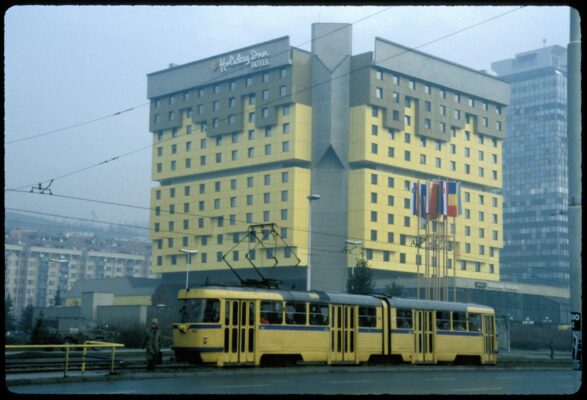
I sometimes write more articles like this at Common Sense and Whiskey.
